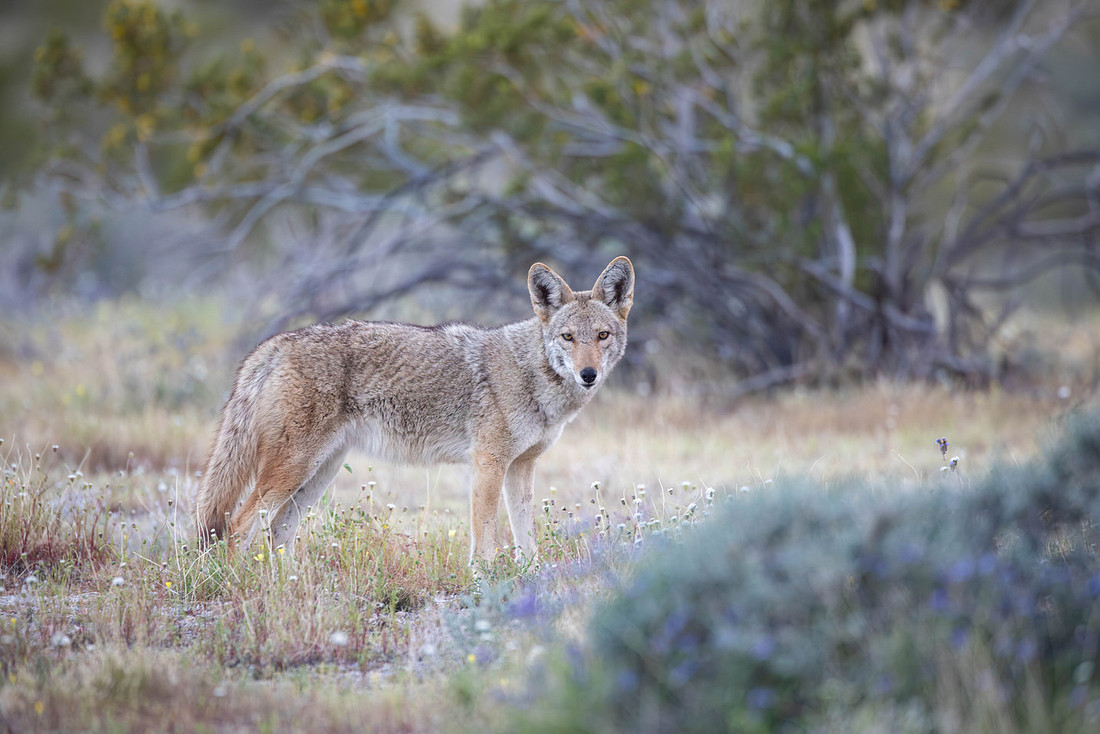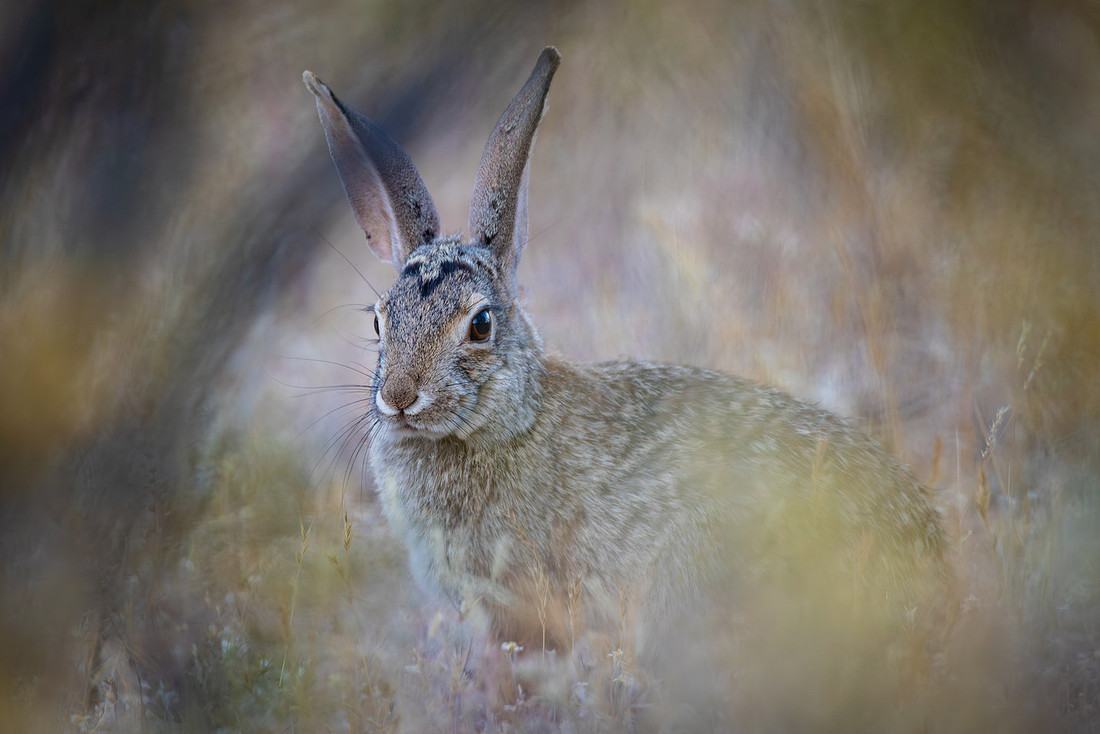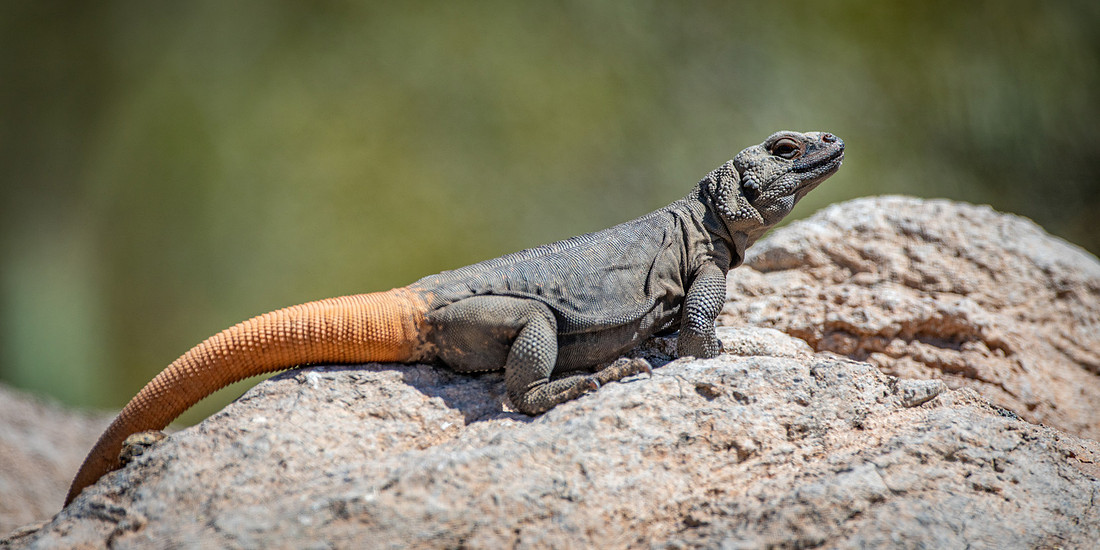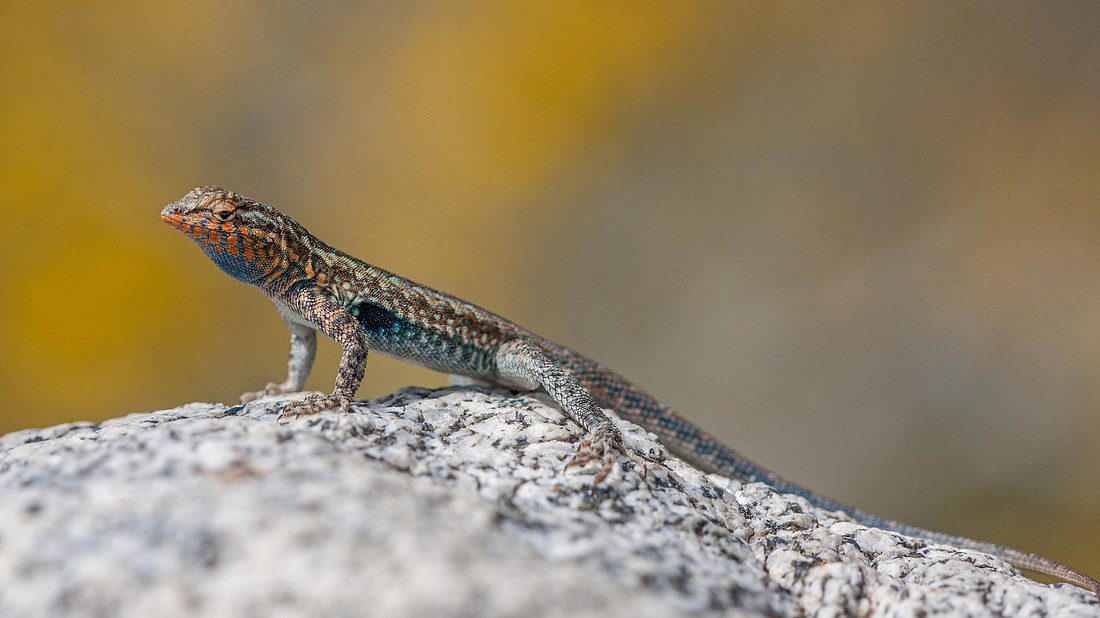Wildlife of Organ Pipe Cactus National Monument
Fur, Scales, and Feathers: A Wildlife Journey Through Organ Pipe Cactus National Monument
Text and photos by Heather Cline
Organ Pipe Cactus National Monument is an ecologically rich desert landscape located in southern Arizona along the U.S.–Mexico border. It sits within the Sonoran Desert, featuring mountain ranges and flat desert basins formed through tectonic activity over millions of years. The monument is named for the organ pipe cactus, a rare species that only grows naturally within its boundaries in the U.S. With over 500 square miles of protected land—95% designated wilderness—it’s a haven for wildlife and a dream for photographers seeking solitude, texture, and light.
This is photo tour covers some of the mammals, Reptiles and birds you may find in this park.
Mammals
Though often elusive, the mammals of Organ Pipe play vital roles in the ecosystem, from seed dispersal to predator-prey dynamics. In this section, I’ll share the mammals I observed, the habitats they favored, and the fascinating adaptations that help them thrive in this arid, rugged landscape.
Reptiles
These cold-blooded inhabitants are masters of desert survival, each adapted to thrive in the extremes of heat and scarcity. In this section, I’ll share where I encountered them, what makes each species unique.
Birds
During my visits to this monument, birds proved to be the most abundant and expressive wildlife. IIn this section, I’ll share where I spotted them and what makes each of these feathered residents fascinating.
  🡅 American Kestrel: North America's smallest falcon, the kestrel has adapted to the Sonoran Desert by using native cacti as nesting sites and preying on the local desert wildlife. The monument's unique landscape provides a critical habitat for this tiny, yet fierce, raptor.
🡅 American Kestrel: North America's smallest falcon, the kestrel has adapted to the Sonoran Desert by using native cacti as nesting sites and preying on the local desert wildlife. The monument's unique landscape provides a critical habitat for this tiny, yet fierce, raptor. |
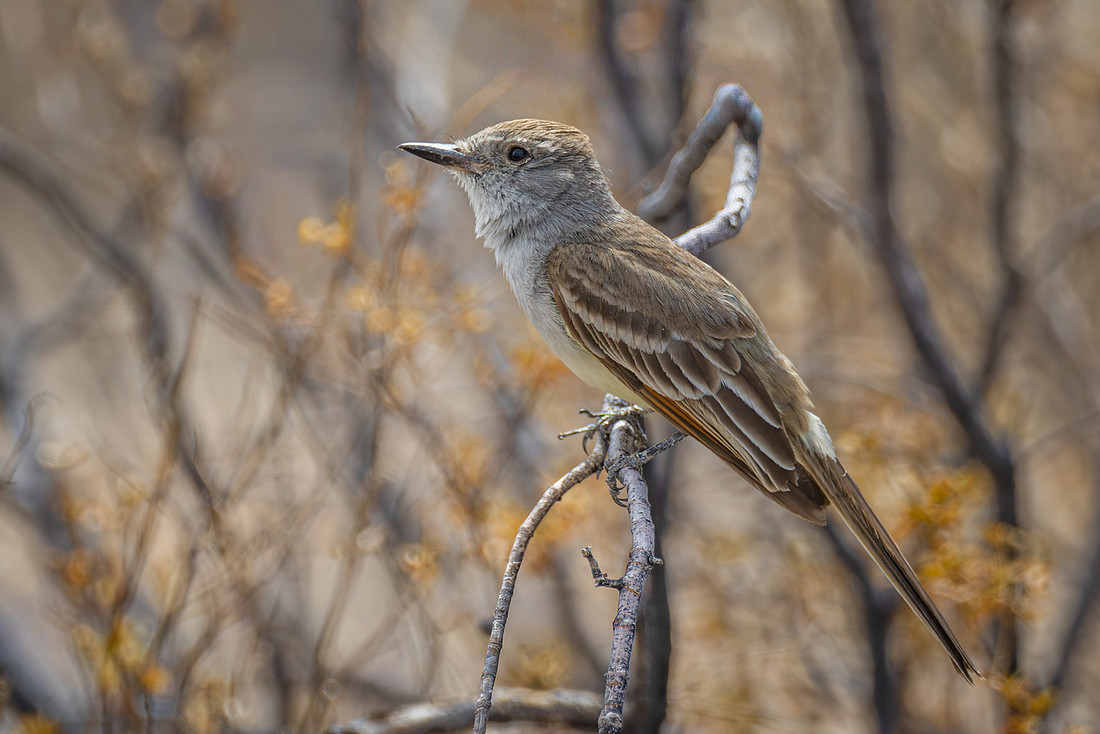 
🡅 Ash-throated Flycatcher: The ash-throated flycatcher gets all the water it needs from the insects and spiders it eats, meaning it does not need to drink water. This allows it to thrive in hot, dry climates where surface water is not readily available. |
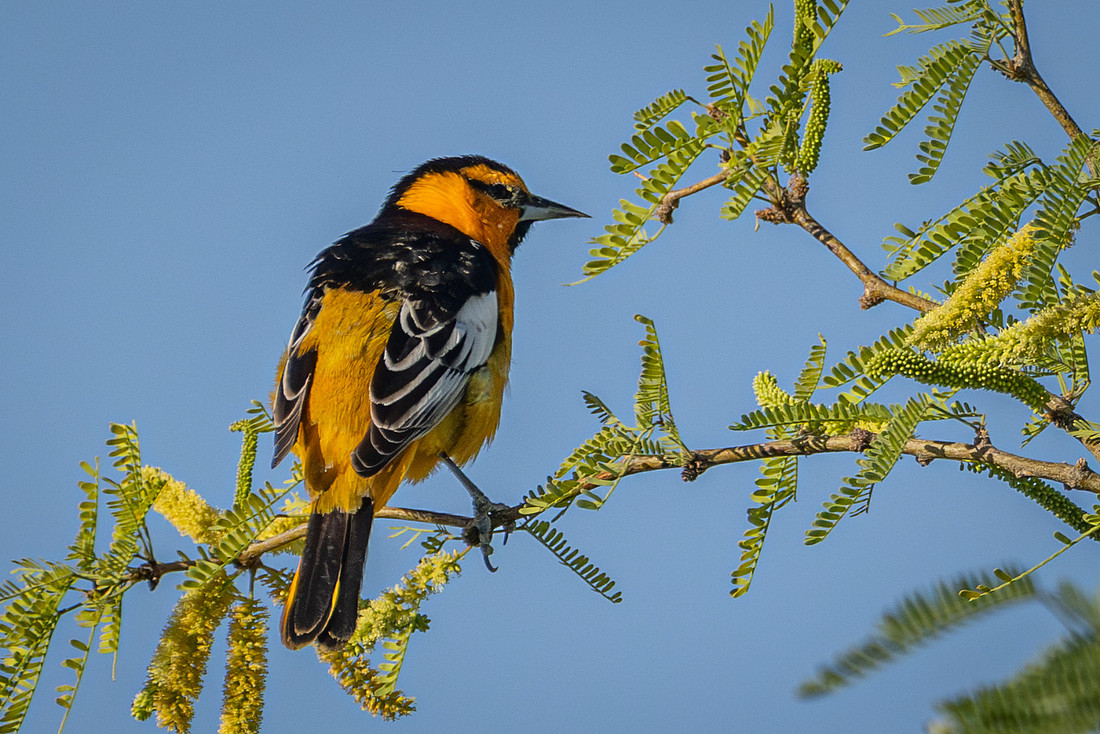  🡅 Bullock's Oriole: While the monument is known for its cacti, Bullock's Orioles are primarily found in areas with open, deciduous woodlands, specifically near water sources. I saw this one at the one of the rare water sources in the monument, Quitobaquito Springs.
🡅 Bullock's Oriole: While the monument is known for its cacti, Bullock's Orioles are primarily found in areas with open, deciduous woodlands, specifically near water sources. I saw this one at the one of the rare water sources in the monument, Quitobaquito Springs. |
  🡅 Cactus Wren: these birds were a common sight in the park. They have a distinctive call that tells you, you are in the Sonoran Desert. They build nests, like this one in the thorny cholla cactus and saguaros for protection from predators. They are excellent desert survivors, eating insects, fruit, and seeds, and can survive without freestanding water.
🡅 Cactus Wren: these birds were a common sight in the park. They have a distinctive call that tells you, you are in the Sonoran Desert. They build nests, like this one in the thorny cholla cactus and saguaros for protection from predators. They are excellent desert survivors, eating insects, fruit, and seeds, and can survive without freestanding water. |
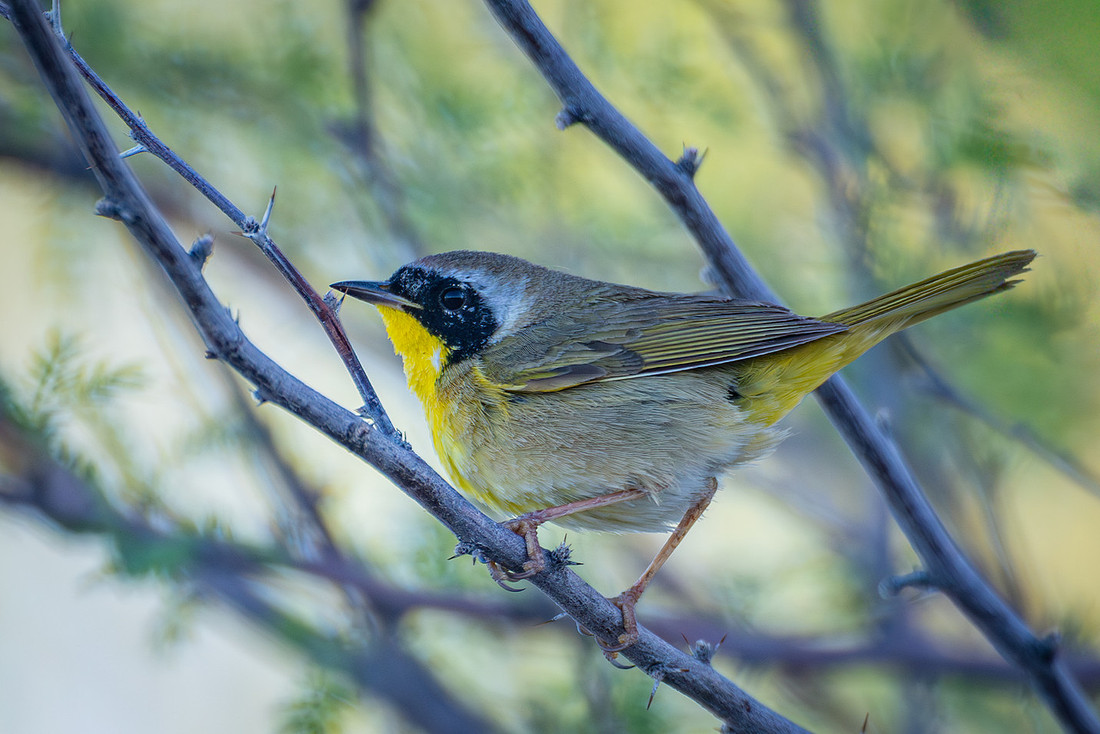  🡅 Common Yellowthroat: this bird is known for their secretive nature and preference for dense, low-lying vegetation. They can be very difficult to spot. I was able to view them at Quitobaquito Springs, a great birding location in the park.
🡅 Common Yellowthroat: this bird is known for their secretive nature and preference for dense, low-lying vegetation. They can be very difficult to spot. I was able to view them at Quitobaquito Springs, a great birding location in the park. |
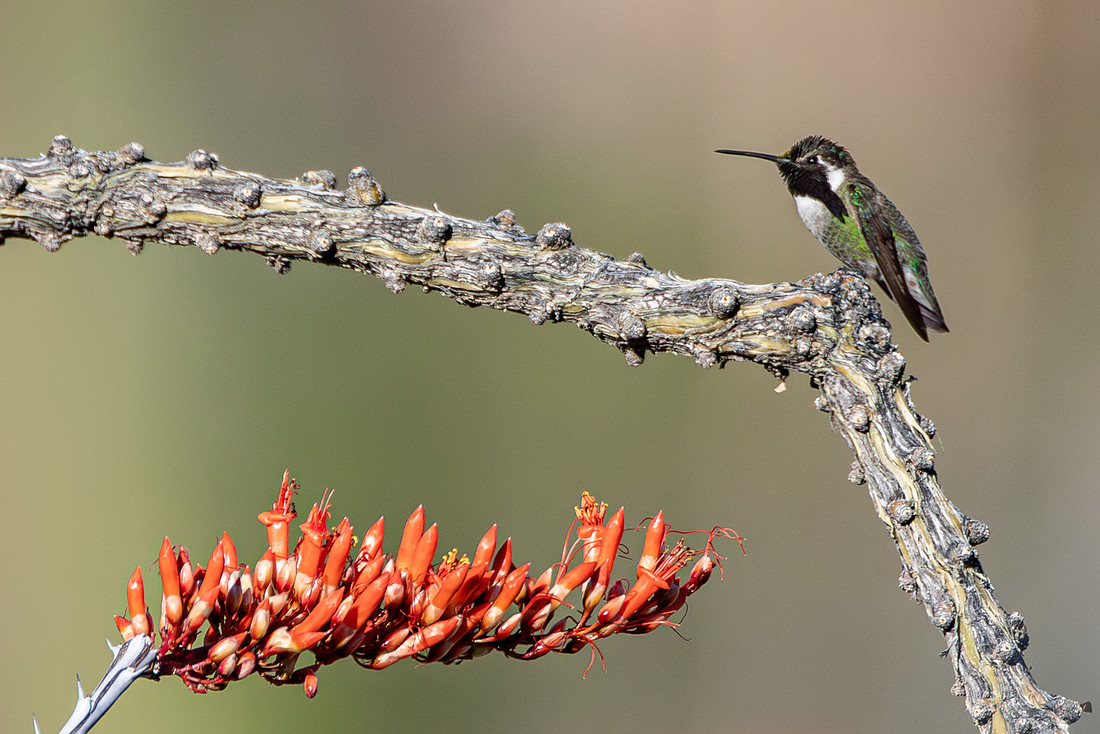  🡅 Costa's Hummingbird: While not as common as some other species, Costa's hummingbirds can be spotted in the monument's desert washes and around the visitor center. Look for them feeding from native plants like chuparosa and ocotillo. Each time I have visited, I have seen them on Ajo Mountain drive.
🡅 Costa's Hummingbird: While not as common as some other species, Costa's hummingbirds can be spotted in the monument's desert washes and around the visitor center. Look for them feeding from native plants like chuparosa and ocotillo. Each time I have visited, I have seen them on Ajo Mountain drive. |
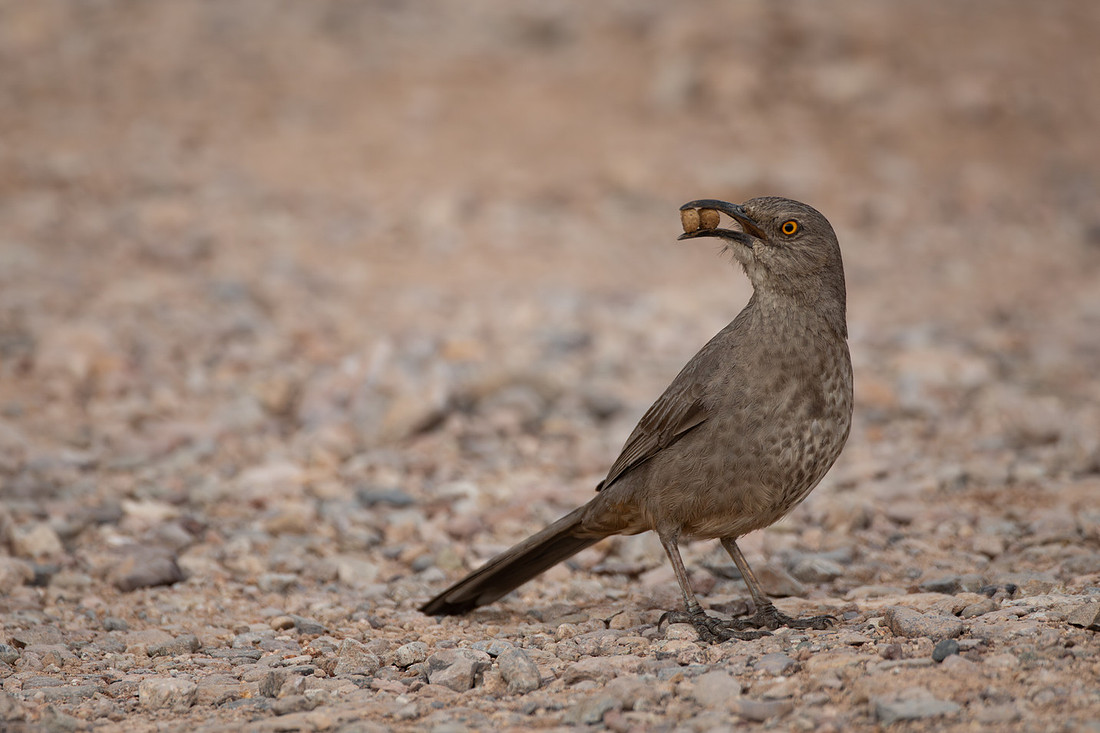  🡅 Curved Bill Thrasher: Its name comes from how it uses its long, curved bill to "thrasher" or sweep through leaf litter and soil, turning over vegetation to find hidden insects. I saw these in the campground, at the visitor center and along Ajo Mountain Drive.
🡅 Curved Bill Thrasher: Its name comes from how it uses its long, curved bill to "thrasher" or sweep through leaf litter and soil, turning over vegetation to find hidden insects. I saw these in the campground, at the visitor center and along Ajo Mountain Drive. |
  🡅 Gambel's Quail (male): considered common in Organ Pipe Cactus, I found them very difficult to spot, despite hearing their distinctive call, "ka-KAA-ka". Both male and female Gambel's Quail sport a tuft of feathers called a topknot, though the male's is typically larger and more prominent.
🡅 Gambel's Quail (male): considered common in Organ Pipe Cactus, I found them very difficult to spot, despite hearing their distinctive call, "ka-KAA-ka". Both male and female Gambel's Quail sport a tuft of feathers called a topknot, though the male's is typically larger and more prominent. |
  🡅 Gila Woodpecker: this bird is a keystone species, with a mutually beneficial relationship with the saguaro cactus that supports numerous other desert animals. These industrious birds create nesting holes in living saguaros that are then used by other wildlife for shelter in the desert's extreme heat. I really enjoyed watching these feasting on Saguaro nectar in the campground.
🡅 Gila Woodpecker: this bird is a keystone species, with a mutually beneficial relationship with the saguaro cactus that supports numerous other desert animals. These industrious birds create nesting holes in living saguaros that are then used by other wildlife for shelter in the desert's extreme heat. I really enjoyed watching these feasting on Saguaro nectar in the campground. |
  🡅 Great Egret: a bird I was not expecting to see in the park, was only visible at Quitobaquito Springs. However, I have heard they can also be spotted at the small pond behind the visitor center and in Alamo Canyon.
🡅 Great Egret: a bird I was not expecting to see in the park, was only visible at Quitobaquito Springs. However, I have heard they can also be spotted at the small pond behind the visitor center and in Alamo Canyon. |
  🡅 Hooded Oriole: one of the more colorful birds I saw enjoys feeding on nectar. I saw one along Ajo Mountain drive (briefly) and out at Quitobaquito Springs.
🡅 Hooded Oriole: one of the more colorful birds I saw enjoys feeding on nectar. I saw one along Ajo Mountain drive (briefly) and out at Quitobaquito Springs. |
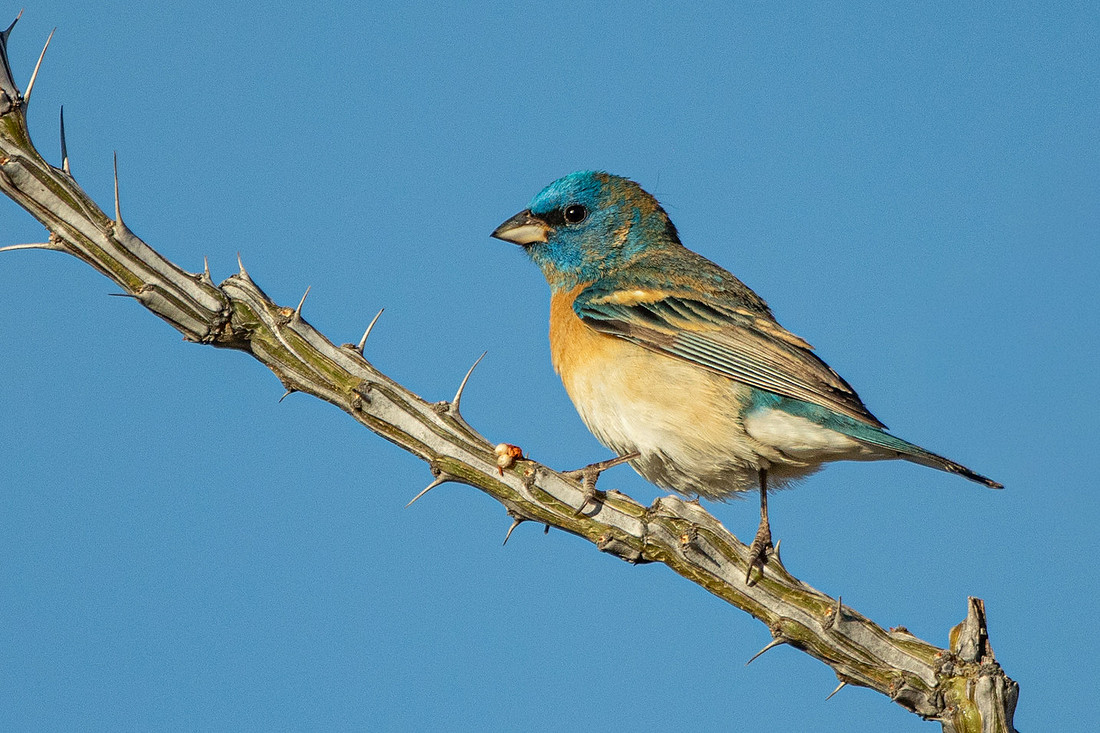  🡅 Lazuli Bunting: this is a spring migrant that is related to cardinals and grosbeaks. This one was at the visitor center and it's striking blue and gold coloring had me mesmerized!
🡅 Lazuli Bunting: this is a spring migrant that is related to cardinals and grosbeaks. This one was at the visitor center and it's striking blue and gold coloring had me mesmerized! |
  🡅 Lincoln's Sparrow: a migration resident that can be difficult to spot with their secretive behavior and ability to hide easily among the brush. I caught a quick peek at this one at Quitobaquito Springs.
🡅 Lincoln's Sparrow: a migration resident that can be difficult to spot with their secretive behavior and ability to hide easily among the brush. I caught a quick peek at this one at Quitobaquito Springs. |
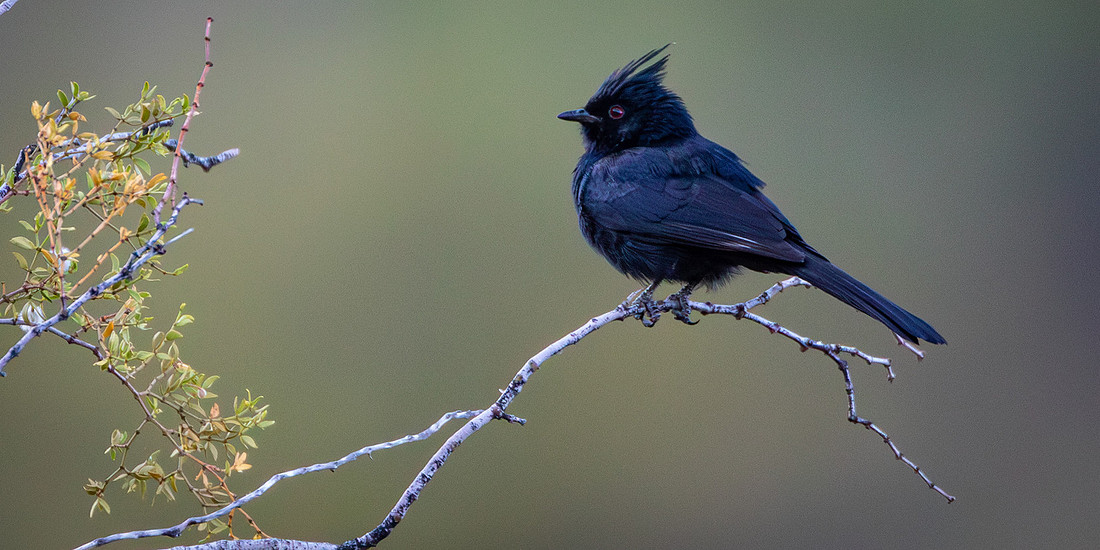  🡅 Phainopepla: these birds spend winters in the Sonoran Desert feeding almost exclusively on the parasitic desert mistletoe berries found growing on mesquite and palo verde trees. To get enough moisture and energy, the bird must consume a massive number of berries. It may eat up to 1,100 mistletoe berries in a single day.
🡅 Phainopepla: these birds spend winters in the Sonoran Desert feeding almost exclusively on the parasitic desert mistletoe berries found growing on mesquite and palo verde trees. To get enough moisture and energy, the bird must consume a massive number of berries. It may eat up to 1,100 mistletoe berries in a single day. |
  🡅 Pied-billed Grebe: another bird I was not expecting to see out at the monument. Due to their reliance on water, seeing them is a special sight indeed. Along with many of the birds I saw, this one was at Quitobaquito Springs. It's a long drive along a dirt road but I highly recommend this sight for birders and wildlife photography.
🡅 Pied-billed Grebe: another bird I was not expecting to see out at the monument. Due to their reliance on water, seeing them is a special sight indeed. Along with many of the birds I saw, this one was at Quitobaquito Springs. It's a long drive along a dirt road but I highly recommend this sight for birders and wildlife photography. |
  🡅 Scott's Oriole (female): this bird arrives to the monument in the spring for breeding season. Good places to see them are in Alamo Canyon and at Quitobaquito Springs. This one was foraging in a mesquite tree where they sometimes make their nests.
🡅 Scott's Oriole (female): this bird arrives to the monument in the spring for breeding season. Good places to see them are in Alamo Canyon and at Quitobaquito Springs. This one was foraging in a mesquite tree where they sometimes make their nests. |
  🡅 Solitary Sandpiper: this is an infrequent visitor to the monument, stopping at isolated ponds and springs as it migrates north for the summer. As their name suggests, they are almost always alone on their migration route.
🡅 Solitary Sandpiper: this is an infrequent visitor to the monument, stopping at isolated ponds and springs as it migrates north for the summer. As their name suggests, they are almost always alone on their migration route. |
  🡅 Townsend Warbler: these striking birds split their time between their breeding grounds in coniferous forests of the Pacific Northwest, Canada, and Alaska and the desert oases as pit-stops on their migration journey.
🡅 Townsend Warbler: these striking birds split their time between their breeding grounds in coniferous forests of the Pacific Northwest, Canada, and Alaska and the desert oases as pit-stops on their migration journey. |
  🡅 Turkey Vulture: this bird is a common sight in the monument, seen soaring overhead in all areas of the park. Their unique features make them well suited for this desert environment.
🡅 Turkey Vulture: this bird is a common sight in the monument, seen soaring overhead in all areas of the park. Their unique features make them well suited for this desert environment. |
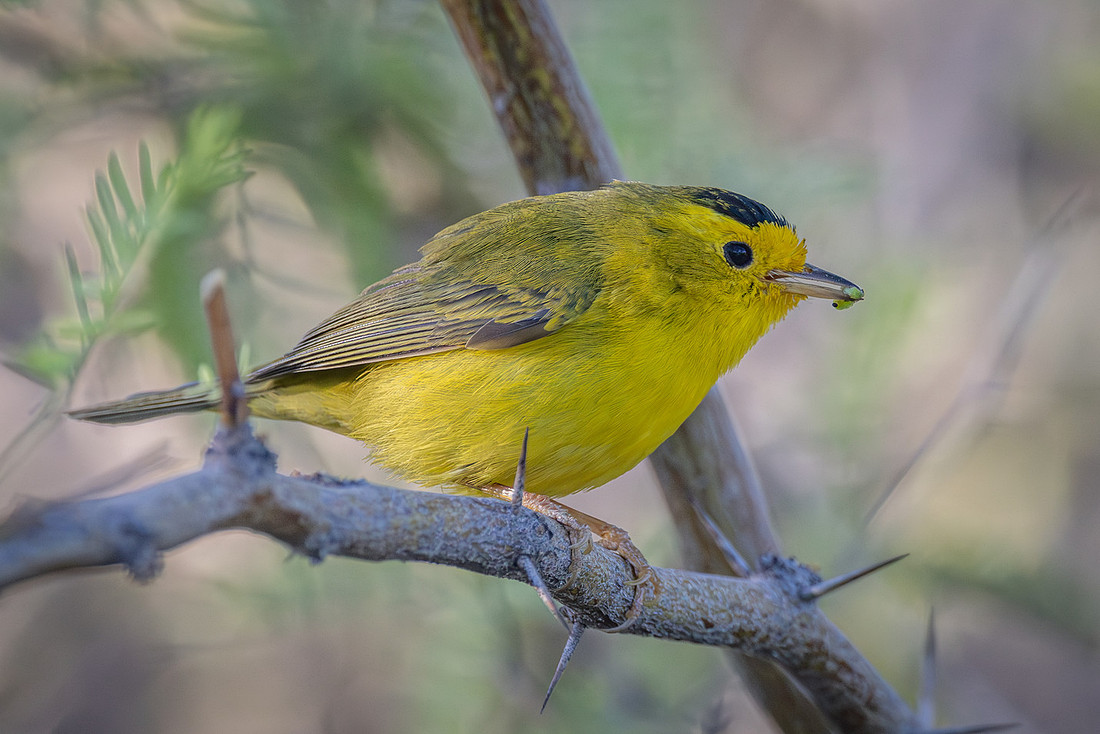  🡅 Wilson's Warbler: The monument is a critical stopover for this long-distance migratory bird. The are most abundant during the spring migration (April–May) and the fall migration (August–October). Their population has been on the decline due to habitat loss so protected places like Organ Pipe Cactus are especially critical for their survival.
🡅 Wilson's Warbler: The monument is a critical stopover for this long-distance migratory bird. The are most abundant during the spring migration (April–May) and the fall migration (August–October). Their population has been on the decline due to habitat loss so protected places like Organ Pipe Cactus are especially critical for their survival. |
Organ Pipe Cactus National Monument is more than just a beautiful desert—it’s a living landscape full of wildlife, each species uniquely adapted to survive and thrive in this rugged environment. From the mammals that move quietly through washes, to the reptiles basking on sunlit rocks, and the birds that fill the air with sound and color, every encounter is a gift. I hope this photo tour gives you a glimpse into the diversity and wonder of the Sonoran Desert.

